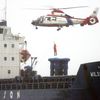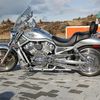1.2.2008 | 13:56
5 įr frį žvķ aš Columbia fórst.
Žann 1. febrśar 2003 kl 09:00 EST fórst geimferjan Columbia viš endurkomu til jaršar eftir 16 daga ferš viš vķsinda rannsóknir.
Um borš voru 7 geimfarar:
Rick Husband (commander), Willie McCool (pilot), Michael P. Anderson, Laurel B. Clark, David M. Brown, Ilan Ramon, and Kalpana Chawla.
Įstęša slyssins var aš aš gat hafši komiš į frambrśn vęngs er einangrun losnaši viš geimskot 16 dögum įšur og viš endurkomu ķ lofthjśpin komst heitt gas (plasma) inn og eyšilagši buršarbita vęngsins.
Geimskot Columbia ķ hinstu för:

Sķšustu samkipti ferjunnar viš Houston - hljóšskrį(vma).
Jeff Kling, an engineer who was working the mechanical-systems position known as MMACS (pronounced Macs), had witnessed a swarm of erratic indications and sensor failures. The pattern was disconcerting because of the lack of common circuitry that could easily explain the pattern of such failures-a single box that could be blamed.
Kling had been bantering good-naturedly on an intercom with one of his team, a technician sitting in one of the adjoining back rooms and monitoring the telemetry, when the technician noted a strange failure of temperature transducers on a hydraulic return line. The technician said, "We've had some hydraulic 'ducers go off-scale low."
Kling had seen the same indications. He said, "Well, I guess!"
The technician said, "What in the world?"
Kling said, "This is not funny. On the left side."
The technician confirmed, "On the left side ..."
Now Kling got onto the main control-room intercom to the lead controller on duty, known as the flight director, a man named Leroy Cain. In the jargon-laced language of the control room Kling said, "Flight, Macs."
Cain said, "Go ahead, Macs."
"FYI, I've just lost four separate temperature transducers on the left side of the vehicle, hydraulic return temperatures. Two of them on system one, and one in each of systems two and three."
Cain said, "Four hyd return temps?"
Kling answered, "To the left outboard and left inboard elevon."
"Okay, is there anything common to them? DSC or MDM or anything? I mean, you're telling me you lost them all at exactly the same time?"
"No, not exactly. They were within probably four or five seconds of each other."
Cain struggled to assess the meaning. "Okay, where are those ... where is that instrumentation located?"
Kling continued to hear from his back-room team. He said, "All four of them are located in the aft part of the left wing, right in front of the elevons ... elevon actuators. And there is no commonality."
Cain repeated, "No commonality."
But all the failing instruments were in the left wing. The possible significance of this was not lost on Cain: during the launch a piece of solid foam had broken off from the shuttle's external fuel tank, and at high speed had smashed into the left wing; after minimal consideration the shuttle program managers (who stood above Mission Control in the NASA hierarchy) had dismissed the incident as essentially unthreatening. Like almost everyone else at NASA, Cain had taken the managers at their word-and he still did. Nonetheless, the strange cluster of left-wing failures was an ominous development. Kling had more-specific reasons for concern. In a wonkish, engineering way he had discussed with his team the telemetry they might observe if a hole allowed hot gases into the wing during re-entry, and had come up with a profile eerily close to what was happening now. Still, he maintained the expected detachment.
Cain continued to worry the problem. He asked for reassurance from his "guidance, navigation, and control" man, Mike Sarafin. "Everything look good to you, control and rates and everything is nominal, right?"
Sarafin said, "Control's been stable through the rolls that we've done so far, Flight. We have good trims. I don't see anything out of the ordinary."
Cain directed his attention back to Kling: "All other indications for your hydraulic systems indications are good?"
"They're all good. We've had good quantities all the way across."
Cain said, "And the other temps are normal?"
"The other temps are normal, yes, sir." He meant only those that the telemetry allowed him to see.
Cain said, "And when you say you lost these, are you saying they went to zero ..."
"All four of them are off-scale low."
"... or off-scale low?"
Kling said, "And they were all staggered. They were, like I said, within several seconds of each other."
Cain said, "Okay."
But it wasn't okay. Within seconds the Columbia had crossed into Texas and the left-tire-pressure indications were dropping, as observed also by the cockpit crew. Kling's informal model of catastrophe had predicted just such indications, whether from blown tires or wire breaks. The end was now coming very fast.
Kling said, "Flight, Macs."
Cain said, "Go."
"We just lost tire pressure on the left outboard and left inboard, both tires."
Cain said, "Copy."
At that moment, twenty-three seconds after 7:59 local time, the Mission Control consoles stopped receiving telemetry updates, for reasons unknown. The astronaut sitting beside Cain, and serving as the Mission Control communicator, radioed, "And Columbia, Houston, we see your tire-pressure messages, and we did not copy your last call."
At the same time, on the control-room intercom, Cain was talking again to Kling. He said, "Is it instrumentation, Macs? Gotta be."
Kling said, "Flight, Macs, those are also off-scale low."
From the speeding shuttle Rick Husband-Air Force test pilot, religious, good family man, always wanted to be an astronaut-began to answer the communicator. He said, "Roger, ah," and was cut off on a word that began with "buh ..."
It turned out to be the Columbia's last voice transmission. Brief communication breaks, however, are not abnormal during re-entries, and this one raised no immediate concern in Houston.
People on the ground in Dallas suddenly knew more than the flight controllers in Houston. Four seconds after eight they saw a large piece leave the orbiter and fall away. The shuttle was starting to come apart. It continued intermittently to send telemetry, which though not immediately displayed at Mission Control was captured by NASA computers and later discovered; the story it told was that multiple systems were failing. In quick succession two additional chunks fell off.
Down in the control room Cain said, "And there's no commonality between all these tire-pressure instrumentations and the hydraulic return instrumentations?"
High in the sky near Dallas the Columbia's main body began to break up. It crackled and boomed, and made a loud rumble.
Kling said, "No, sir, there's not. We've also lost the nose-gear down talkback, and right-main-gear down talkback."
"Nose-gear and right-main-gear down talkbacks?"
"Yes, sir."
At Fort Hood, Texas, two Dutch military pilots who were training in an Apache attack helicopter locked on to the breakup with their optics and videotaped three bright objects-the main rocket engines-flying eastward in formation, among other, smaller pieces and their contrails.
Referring to the loss of communications, one minute after the main-body breakup, Laura Hoppe, the flight controller responsible for the communications systems, said to Cain, "I didn't expect, uh, this bad of a hit on comm."
Cain asked another controller about a planned switchover to a ground-based radio ahead, "How far are we from UHF? Is that two-minute clock good?"
Kling, also, was hanging on to hope. He said, "Flight, Macs."
Cain said, "Macs?"
Kling said, "On the tire pressures, we did see them go erratic for a little bit before they went away, so I do believe it's instrumentation."
"Okay."
At about that time the debris began to hit the ground. It fell in thousands of pieces along a swath ten miles wide and 300 miles long, across East Texas and into Louisiana. There were many stories later. Some of the debris whistled down through the leaves of trees and smacked into a pond where a man was fishing. Another piece went right through a backyard trampoline, evoking a mother's lament: "Those damned kids ..." Still another piece hit the window of a moving car, startling the driver. The heaviest parts flew the farthest. An 800-pound piece of engine hit the ground in Fort Polk, Louisiana, doing 1,400 mph. A 600-pound piece landed nearby. Thousands of people began to call in, swamping the 911 dispatchers with reports of sonic booms and metal falling out of the sky. No one, however, was hit. This would be surprising were it not for the fact, so visible from above, that the world is still a sparsely populated place.
In Houston the controllers maintained discipline, and continued preparing for the landing, even as they received word that the Merritt Island radar, in Florida, which should by now have started tracking the inbound craft, was picking up only false targets. Shuttles arrive on time or they don't arrive at all. But, repeatedly, the communicator radioed, "Columbia, Houston, UHF comm check," as if he might still hear a reply. Then, at thirteen minutes past the hour, precisely when the Columbia should have been passing overhead the runway before circling down for a landing at the Kennedy Space Center, a phone call came in from an off-duty controller who had just seen a video broadcast by a Dallas television station of multiple contrails in the sky. When Cain heard the news, he paused, and then put the contingency plan into effect. To the ground-control officer he said, "GC, Flight."
"Flight, GC."
"Lock the doors."
"Copy."
The controllers were stunned, but lacked the time to contemplate the horror of what had just happened. Under Cain's direction they set about collecting numbers, writing notes, and closing out their logs, for the investigation that was certain to follow. The mood in the room was somber and focused. Only the most basic facts were known: the Columbia had broken up at 200,000 feet doing 12,738 mph, and the crew could not possibly have survived. Ron Dittemore, the shuttle program manager, would be talking to reporters later that day, and he needed numbers and information. At some point sandwiches were brought in and consumed. Like the priests who harvest faith at the bedsides of the dying, grief counselors showed up too, but they were not much used.
Cain insisted on control-room discipline. He said, "No phone calls off site outside of this room. Our discussions are on these loops-the recorded DVIS loops only. No data, no phone calls, no transmissions anywhere, into or out."


 jgo
jgo
 photo
photo
 gudni-is
gudni-is
 jari
jari
 valli57
valli57





Bęta viš athugasemd [Innskrįning]
Ekki er lengur hęgt aš skrifa athugasemdir viš fęrsluna, žar sem tķmamörk į athugasemdir eru lišin.